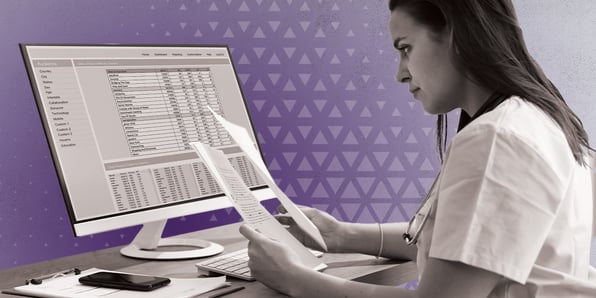What is Claim Scrubbing & How it Can Prevent Claim Denials

Healthcare providers face the challenge of dealing with claim denials on a regular basis. According to Public Broadcasting Service (PBS), health insurance companies denied more than 49 million claims in 2021 alone. One reason behind these denials is incorrect billing codes or missing information on the claim.
Busy clinicians deserve to get paid on time for their services. So how can you avoid costly and time-consuming denials? An excellent method is claim scrubbing — an essential process that helps you analyze claims and identify any errors.
How does claim scrubbing work to prevent claim denials, and how does it fit into the revenue cycle management (RCM) process? Read on to find the answers.
What is Claim Scrubbing?
Claim scrubbing is an integral part of the medical billing process. In essence, it is the process of checking medical claims for errors before you send them to the payer. It involves examining the claim for inaccuracies, inconsistencies, or missing information that could lead to a claim denial or delay in payment.
The claim scrubbing process works by utilizing software that applies a set of pre-determined rules to identify potential errors within a claim. These rules can include:
- Checking for correct patient information
- Proper coding of procedures, services, or items
- Compliance with insurance policies and regulations
How Can Claim Scrubbing Prevent Denials?
Claim scrubbing plays a pivotal role in the prevention of claim denials through:
- Error identification. By checking for inaccuracies, inconsistencies, or missing information, claim scrubbing can identify potential issues that could lead to claim denial.
- Compliance verification. Claim scrubbing ensures that the claim complies with insurance policies and regulations, reducing the risk of denials due to non-compliance.
- Correct coding. Scrubbing verifies the proper coding — including modifiers — of procedures, services, or items. The verification prevents denials due to incorrect or mismatched codes.
- Duplicate billing prevention. Submitting the same claim multiple times can cause confusion and denials. Scrubbing ensures each submission is unique and valid.
- Provider information validation. The scrubbing process verifies the accuracy of the provider's information, such as the National Provider Identifier (NPI).
- Patient eligibility confirmation. By checking the patient's insurance eligibility and coverage details, claim scrubbing can prevent denials related to coverage issues. It confirms whether the services or procedures are covered under the patient's insurance plan.
So by employing claim scrubbing, you can ensure smoother revenue flow and more efficient operations.
But how does claim scrubbing fit into revenue cycle management (RCM), and what benefits can RCM bring?
Benefits of RCM in Relation to Claim Scrubbing
RCM is another significant aspect of medical billing. It is an intricate process that involves managing the financial processes associated with healthcare — from patient registration and appointment scheduling to the final payment of the balance.
In short, RCM ensures that healthcare providers get paid for their services correctly and on time. Claim scrubbing is a vital part of the RCM process.
So what are some of the benefits of RCM in relation to claim scrubbing? Consider five notable advantages:
- Increased accuracy. RCM incorporates claim scrubbing as part of its process, increasing the accuracy of claims and reducing the likelihood of denials.
- Enhanced cash flow. By reducing denials and ensuring accurate, timely claims, RCM can enhance cash flow for a healthcare practice.
- Improved efficiency: RCM streamlines the billing process, incorporating steps like claim scrubbing to improve efficiency and reduce administrative burden.
- Compliance assurance. RCM systems are designed to stay up-to-date with the constantly changing regulations and rules in the healthcare sector. RCM assures compliance with these regulations, reducing the risk of penalties and denials due to non-compliance.
- Reduced costs. When used in conjunction with claim scrubbing, RCM automates various tasks. This automation reduces the need for manual intervention, which can significantly reduce overhead costs associated with the billing process.
These benefits underscore the integral role of RCM and claim scrubbing in efficient medical practice management. When you embrace these processes, you can improve your financial performance, enhance patient satisfaction and operational efficiency.
Avoid Claim Denials by Partnering with Top Tier Medical Billing Company
Claim scrubbing is a crucial aspect of the medical billing process that helps to prevent claim denials and enhance RCM. By checking for errors, ensuring compliance, and verifying correct coding, claim scrubbing increases the accuracy and efficiency of medical billing. This leads to improved cash flow and financial health for medical practices.
Are you ready to take a more comprehensive and efficient approach to medical billing? Consider partnering with a professional medical billing company like PUREDI. As a leader in medical billing services and software, we can help streamline your billing process, improve claim accuracy, and reduce denials. Contact us today to see how our targeted solutions can transform your medical billing and RCM processes.
Blog Post Tags
RCMGet Awesome Content Delivered Straight to Your Inbox!
Posts by topic
- RCM
- Medical Billing Software
- Outsource Your Medical Billing
- Compliance
- Physician Billing Services
- Denial Management
- AI
- Data Analytics
- EHR
- ERA
- reporting
- Automation
- Business
- Claim Scrubbing
- Coding
- Community
- Events
- LTPAC
- Medical Billing Companies
- Medicare
- Press Release
- Revenue Cycle Management
- business development
- clearinghouse See All See Less





